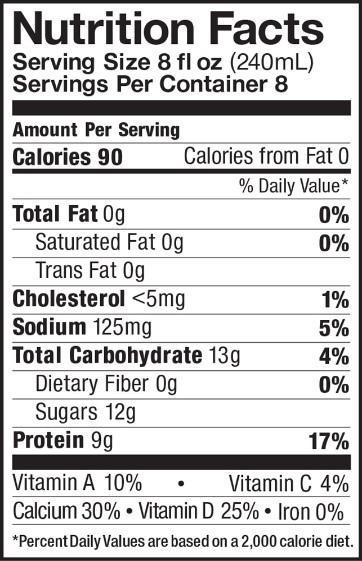The “Nutrition Facts” shown on food labels are supposed to give you useful information on the nutritional value of what you’re buying as well as disclose the ingredients, so you can decide if it’s right for you.
Unfortunately, it’s not that cut and dry.
Instead food manufacturers use several little tricks to mislead you, fool you or out and out lie to you to compel you to buy their products…even if that means jeopardizing your health!
Here is what’s showing (and not showing) on food labels, and what you must know to not only avoid poor nutrition but also make great strides in preventing sickness and disease.
The anatomy of a food label
When processed convenience foods were first introduced in the early 20th century, food manufacturers in the US could put pretty much anything they wanted on a food label…and of course the flip side was also true in that they could omit what they wanted to as well.
That changed in 1973 when the US Food & Drug Administration (FDA) implemented a series of rules designed to help consumers become more aware of exactly what they were buying…but as you’ll soon see, that’s not always the case.
Required components of a food label include the following:
- Product name and place of business
- Product weight
- Ingredients, from most abundant to least
- Company name and address
- Country of origin
- UPC bar code
- “Best by” date
- Religious symbols if applicable (such as “kosher”)
- Safe handling instructions if applicable
- Special warning instructions (such as with peanuts because of allergies)
- Nutrition facts panel
The ins and outs of nutrition facts
Although it seems like nutrition “facts” should be straightforward, here are some ways that the waters get muddied:
Serving size
The nutrition facts are based upon a specified serving size…and many times the “serving size” would not be enough to sustain a bird let alone a human being.
For example, the typical serving size for ice cream is 1/2 cup. Tell me, when was the last time you ate just 1/2 cup of ice cream?
Breakfast cereals are another one. The typical serving sizes range from 1/2 cup to 3/4 cup. I bet you haven’t eaten just half a cup of cereal since you were a toddler.
Pasta is another culprit. That 16 oz. box of spaghetti is supposed to serve 8 people—not 2.
So when you’re reading labels, it’s important to realize how much you actually eat and do the math.
Daily values and percent daily values
Daily values (DV) and Percent daily values (%DV) were designed to be a benchmark so you could have an idea of how close you were coming to satisfying your body’s nutritional needs.
But these too can be extremely misleading.
First of all, the daily values represent the minimum amount of a nutrient you must have to avoid a serious deficiency. This is a far cry in many cases to how much you should have of a nutrient to stay healthy.
For example, the daily value of Vitamin C is 60 mg/day—that’s about enough to guarantee you won’t get scurvy.
Plus the percent daily values were designed so you could see what percentage of your “needs” would be met by the product.
But these percentages are based on a 2,000-calorie diet. So if your typical diet is more than 2,000 calories a day, those percentages will be lower for you.
What they don’t say
Arguably more significant than what nutrition panels say is what they DON’T say.
For example, food manufacturers are not required to disclose on a food label if they use GE (genetically engineered) or GMO (genetically modified organism) ingredients.
Current estimates are that GMO or GE ingredients are present in as many as 80-90 percent of the packaged foods on our shelves!
And products that are labeled “Zero grams trans-fats” can actually contain up to .5 grams of trans-fats per serving…so zero doesn’t actually mean zero.
Plus food manufacturers can remain completely mum on what all those chemicals, artificial ingredients and preservatives really are…as well as the potential health dangers they pose!
What to do now?
Here are 3 ways that you can help minimize the dangers of processed foods in your life, and create a healthier you!
1) Avoid processed foods
There's no chance of getting misled or downright fooled by food labels if you don't buy boxed or packaged stuff to begin with.
And if you must buy a processed food, seek out organic options.
2) Eat real food and educate yourself
Follow a reliable program that will educate you on the dangers of packaged foods, show you how to structure healthy, easier to digest meals, and guide you on preparing REAL foods that are positively scrumptious.
And that is what my Great Taste No Pain health system will do for you!
Great Taste No Pain will teach you all the ways that packaged foods can be so harmful to your health.
You’ll also learn what foods to eat together to pave the way for easier digestion that can help curb gas, bloating, heartburn and constipation.
And the recipe section is loaded with delicious dishes featuring REAL foods that will help nourish your body and make your taste buds dance.
3) Make sure your nutritional bases are covered
Even the healthiest of diets can leave you open to one or more nutritional deficiencies.
That’s because our food is inherently less nutritious than it once was, due to deficiencies in our soil, factory-farming practices and bioengineering of crops.
Plus, many people are running short in their absorption of nutrients due to poor digestion and use of acid reducers.
But a well-rounded, complete multi-vitamin formula like Super Core can ensure that your body has what it needs to keep you healthy!
Super Core provides therapeutic nutrient doses—well beyond the paltry RDAs (which are basically just enough to make sure you don’t keel over).
Super Core helps ensure that ALL your body’s nutritional bases are well-covered, so you can maintain optimal health—not just barely avoid kicking the bucket.
Now you are an expert in what food labels are really saying (and not saying).
And you can make smart, healthy for you and your family.
To your health,
Sherry Brescia












Hello Arline! The net carbs can be listed as a different number at the total carbs. We’d recommend that you reach out to Wellsley Farms directly for confirmation. Have a great day!
I MEANT WELLSLEY FARMS
ONLINE WELLSEY FARMS MULTI-GRAIN BREAD SAYS 20 CARBS PER SLICE. ON THE PACKAGE LABEL IT SAYS 12 CARBS PER SLICE. WHICH IS CORRECT ?